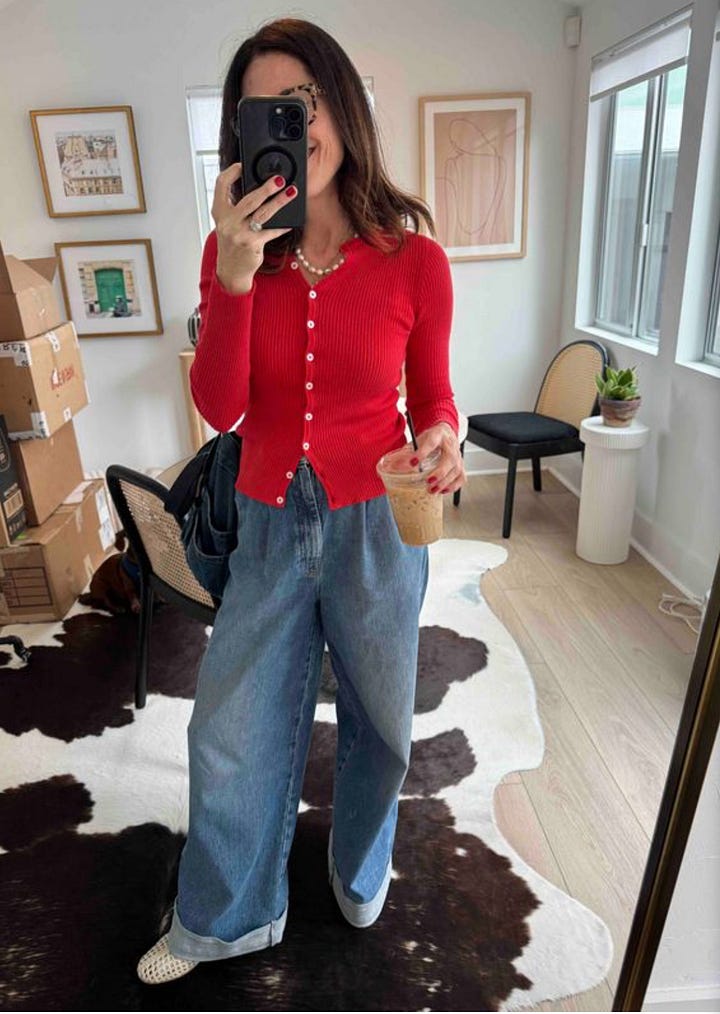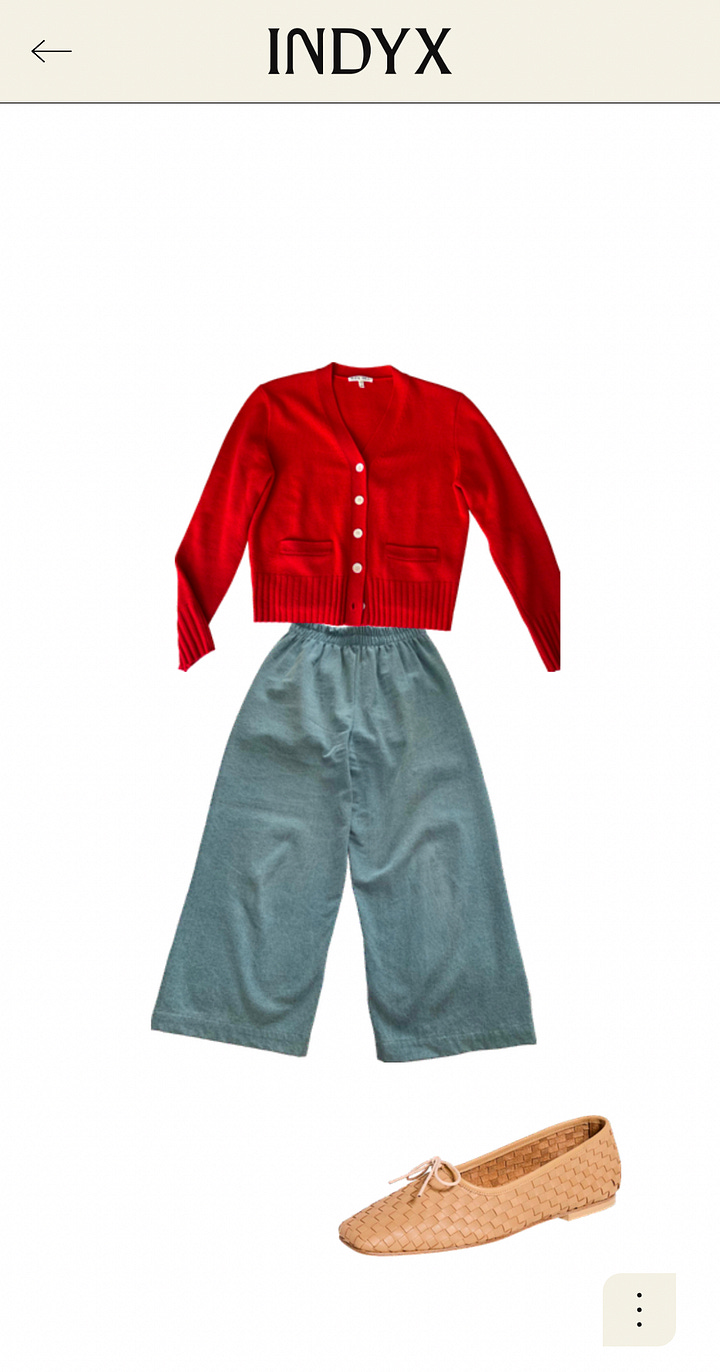Author and Substack expert
recently shared the following advice: “write about what obsesses you.”She asked, “what rabbit hole do you go down that most people don’t?”
My answer is clothing – but aside from one newsletter last year, I haven’t shared much about it.
I boldly declared that post to be the first in a deliberate closet series…but despite receiving a positive response, I’ve yet to write a follow-up.
Thanks to Sarah’s kick in the pants encouragement, I’m committed to sharing my best tips for building and maintaining a deliberate closet via three posts guided by the framework
Adjust volume - figure out the right amount of volume for any given space
Create systems - find the simplest solution to a challenge or problem
Implement habits - form habits so that your system works and maintains itself
Today’s post is all about adjusting volume (as in buying less).
In this post (an 8 minute read), you’ll learn:
The practice that stops me from buying ALL the things
Great advice that it took me a while to follow
A game-changing tool to help with deliberate closeting
Each of these posts will contain bonus content for paid subscribers. At the end of each post, I’ll share the slow fashion brands that have become my wardrobe staples.
Ready? Let’s go!
Note: I’m getting a warning that this is too long for email, so click “view entire message” to read on if it’s cut off!
Do you have volume issues?
When I first shared Shira’s framework, a reader commented “I’m a little worried that I might have volume issues!”
The truth is, most of us do, especially when it comes to our closets.
I will spare you the depressing statistics about the staggering growth in clothing production over the past quarter century (alongside the per capita increase in number of garments purchased and discarded).1

Suffice it to say: in the developed world, we buy more than we need, spend more than we should, and don’t fully wear what we have.
I’m guilty of this, too.
But I also have a small closet, so I’ve learned ways to adjust the volume…
Tip #1: Try a purchase pause
This can be done on multiple levels.
The micro: institute a 48-hour rule before buying any new item. When the urge to purchase strikes, record it (I’m partial to a screenshot, but you can also keep a running “wants” list via your notes app, or add it to a Pinterest board). Then, pause. Come back to your desired item two full days later. When I do this, I often find that the moment has passed and I no longer want the thing.2
The macro: introduce a longer “no buy” period. I found
a few years ago and took her #NoNewThings challenge (she now has a book with the same title I can’t wait to read). The idea is that for a period of time – a month, a quarter, or a year — you commit to buying no new things. Instead, you borrow or make do with what you have. I’ll be doing a “No Buy July” (what can I say, I love a rhyme), so if you’re interested, you can join me next month!
One reason a purchase pause works is it shifts the location of friction from the back end of a purchase to the front end. This is a game-changer, especially for online purchases.
Why? Online shopping has been engineered to be as frictionless as possible on the front end. Retailers want us to “add to cart” and “checkout” before our rational brain gets in the way.
Instead, all the friction is on the back end (if you’ve ever struggled to print out a return shipping label, box up a purchase, and schlep it to a UPS drop-off location, you get it). Many people don’t even bother returning clothing purchases — it’s too much work.
Re-inserting friction at the front end (before you buy something) lets your rational brain chime in; it usually tells you that you don’t really need the thing.
Try it and see how it goes!
Tip #2: Adopt a “fewer, better” mindset
I was raised by bargain shoppers who never met an outlet mall they didn’t like.3 Buying at full price was considered heresy in my family. So I learned to stalk the sales.
Were there things I bought over the years just because they were on sale? Yes. Might I have saved money if I weren’t so obsessed with getting a deal? Also yes.
So what helped me embrace a fewer, better mentality? Hiring a personal stylist, which served as my gateway to higher-end garments.4
Before working with a stylist, I had an (overflowing) closet filled with Anthropologie sale rack finds.
My stylist persuaded me to let go of many items in my wardrobe that were no longer serving me and replace them with fewer, nicer pieces.
The truth is, once I tried on higher-end items, it became hard to go back to my bargain shopper ways.
This isn’t to say that price is always an indicator of quality. There are plenty of expensive items that aren’t high quality, and high quality pieces can be found at lower price points.
My stylist taught me how to create looks that mix quality pieces at different price points. Exhibit A: my last corporate headshot featured a blazer from Sezane with a 100% cotton top from Old Navy and Gap jeans.
Giving myself permission to spend more on one nicer piece (in lieu of several less nice ones) required me to unlearn some of my early conditioning.
But once I did, I discovered that higher-end pieces stand the test of time, which often leads to a lower cost per wear (the metric that matters!).
Tip #3: External Inspiration, Internal Exploration
Growing up, I pored over Bill Cunningham’s street style column in the New York Times. Now, I get my fix from fashion Substacks.
When I see an outfit that catches my eye, I’m often tempted to buy a specific piece to recreate the look. I’ve fallen victim to a well-placed affiliate link, especially when there’s a sale (I’m looking at you, Jenni Kayne!).
Fortunately for my bank account’s sake, I’m a pretty savvy consumer. I have a degree in American Studies, and I wrote my senior essay on the Macy’s Thanksgiving Day Parade; I’ve been thinking critically about shopping for >25 years.5
So I do my best to resist affiliate links, and I even invented a mantra to help me: External Inspiration, Internal Exploration.
What does it mean? When I see an outfit that inspires me, I first try to recreate it using pieces I already have in my closet.
What I find isn’t always an exact match, but the act serves as a purchase pause, forcing me to be creative before mindlessly consuming.
The tool that’s helping me practice my mantra is one I’ve shared before: the Indyx app.
I’ve primarily used Indyx for packing, but I’ve recently started playing around with it for internal exploration.
For instance, I was inspired by an outfit shared by Conni Jespersen (a stylist I’ve worked with virtually in the past). I opened Indyx and assembled a similar look with pieces I already own.


I then wore it during my college reunion. Can you spot me in the front row?
I hope this gave you helpful ideas for how to adjust volume. Next time, I’ll share the systems I use to build and maintain my deliberate closet. Stay tuned…
Deliberately yours,
Abby
Abby’s Latest
As a bonus for paid subscribers, below are the slow fashion brands I rely on for pants, sweaters, t-shirts, blouses and dresses, along with the specific pieces I own and love (no affiliate links here). Incidentally, all the companies mentioned are women-owned.





